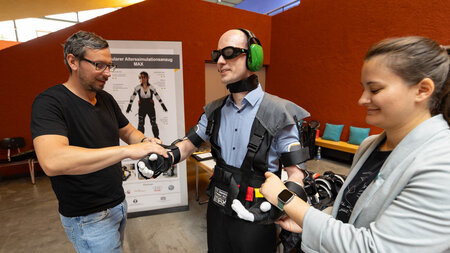Lectures
10.45 am to 11.15 am
V1: „Functional surfaces produced by High Speed Blanking?!” I Dr. Lisa Winter
(Chemnitz University of Technology)
High-speed blanking (HSB) represents an economically and ecologically relevant alternative to conventional cutting processes such as normal or fine blanking or laser cutting for the production of sheet metal parts. Especially for high-strength and ultra-high-strength steels, but also for light metals, HSB has high potential for producing blanked surfaces, which can be used directly as functional surfaces without further mechanical, thermal or thermochemical post-processing steps. Depending on the material and the process parameters, adiabatic shear bands (ASB) can form. These are homogeneous zones clearly delimited from the microstructure of the base material, in which material separation then takes place. The resulting surfaces are characterized by high hardness, small rollover depth and low roughness, and exhibit almost no burr. To the date, there is a lack of fundamental understanding of the mechanisms leading to the formation of ASB in HSB, but this is essential for targeted use of the exceptional surface properties described. The FUNDAM3ENT research group is dedicated to research the material- and process-related factors influencing the microstructure and the ASB formation and, further, the mechanical behavior regarding the fatigue, corrosion and wear resistance depending on the microstructure of the blanked surfaces.
V2: „Software Defined Vehicles – Opportunities and Challenges” I Dr. Katharina Wagner (Vector Informatik GmbH)
Vehicles have been defined by their hardware components for a long time. However, software is more and more the key factor for a vehicle’s functionality. That’s why we talk about software defined vehicles.
This development brought various new opportunities. New features can be added or activated anytime. Updates can be deployed during the whole lifetime of the vehicle. In the development of software, this introduces new challenges. Vector develops various tools and software libraries to overcome these challenges.
11.30 am to 12.00 am
V3: „Temporal AI for health” I Prof. Myra Spiliopoulou
(Otto von Guericke
University Magdeburg)
A description will follow shortly.
V4: „Go Green, Shine Bright: Organic Solar Cells Lighting the Way” I Prof. Saffa Shoaee (University of Potsdam)
Description will follow shortly.
9.00 am to 9.30 am
V5: „Tailoring the electronic structure of epitaxial graphene on SiC” I Dr. Kathrin Küster (Max Planck Institute for Solid State Research, Stuttgart)
Graphene – a single layer of carbon atoms – is, since its discovery almost 20 years ago, one of the most intensely investigated 2D materials due to its unusual electronic properties. The graphitization of SiC surfaces is one of the major fabrication routes for graphene, because it leads to high quality large area graphene, directly grown on a large band gap semiconductor. Our group as part of the DFG research unit FOR 5242 is employing epitaxially grown graphene on SiC in order to study electronic correlations and proximity coupling of 2D materials. In general, we use intercalation –11:55 30.01.2024 the insertion of atoms between the graphene and its SiC support – to modify the electronic properties. In this talk, I will present two different projects of our group. First, I want to show that graphene can be heavily electron doped by intercalation of lanthanides like Gd and Yb. This leads to a strong alteration of graphene’s electronic structure and theory predicts that it might even lead to superconductivity or other correlated phases. In contrast, intercalation of graphene with Pb leads to the formation of almost charge neutral graphene. Besides the influence of the intercalants on the electronic properties of the graphene, also the investigation of the electronic and structural properties of the 2D interlayers is an exciting research area on its own, since they often strongly deviate from their 3D counterparts.
V6: „Stress-based approximations and error estimation in solid mechanics” I Prof. Dr. Fleurianne Bertran (Chemnitz University of Technology)
Better safe than sorry! High accuracy in the determination of material behavior and vibration is crucial in many technical and biomedical applications. How can we make sure that the approximations are reliable? Can we reduce the computational effort with guaranteed error bounds? This presentation delves into the latest research efforts aimed at achieving accurate stress approximations for those material behavior and vibrations. It focuses on addressing the limitations of traditional finite elements, in order to describe complex material behavior and engineer new metamaterials. In fact, stress-based finite element methods are particularly useful in error estimation, laying the groundwork for adaptive refinement strategies. This concept builds upon the hypercircle theorem [1], which states that in a specific energy space, both the exact solution and any admissible stress field lie on a hypercircle. However, the construction of finite element spaces that satisfy admissible states for complex material behavior is not straightforward. It often requires a relaxation of specific properties, especially when dealing with non-symmetric stress tensors [2] or hyperelastic materials. Alternatively, methods that directly approximate stresses can be employed, offering high accuracy of the stress fields and adherence to physical conservation laws. However, when approximating eigenvalues, this significant benefit for the solution's accuracy implies that the solution operator cannot be compact. To address this, the solution operator must be confined to a subset of the solution that excludes the stresses. Yet, due to compatibility conditions, the trial space for the other solution components typically does not yield the desired accuracy. The second part of this talk will therefore explore the Least-Squares method as a remedy to these challenges [3].
To conclude this talk, we will emphasize the integration of those methods within global solution strategies, with a particular focus on the challenges regarding model order reduction methods [4].
[1] W. Prager, J. Synge. Approximations in elasticity based on the concept of function space. Quarterly of Applied Mathematics 5(3), 1947.
[2] FB, K. Bernhard, M. Moldenhauer, G. Starke. Weakly symmetric stress equilibration and a posteriori error estimation for linear elasticity, Numerical Methods for Partial Differential Equations 37(4), 2021.
[3] FB, D. Boffi. First order least-squares formulations for eigenvalue problems, IMA Journal of Numerical Analysis 42(2), 2023.
[4] FB, D. Boffi, A. Halim. A reduced order model for the finite element approximation of eigenvalue problems,Computer Methods in Applied Mechanics and Engineering 404, 2023
9.45 am to 10.15 am
V7: „Process mining to analyze unstructured data” I Prof. Agnes Koschmider (University of Bayreuth)
Unstructured data is a common data format in many disciplines. Data is referred to as unstructured when it is not organized in a scheme that enables the retrieval of information as required by the desired application. The volume of unstructured data (e.g., images, audio, video, documents, social media, or sensor data) is continuously increasing and the ability and demand to efficiently analyze the data has become even more crucial. Process mining is a promising approach to find patterns (e.g., in terms of causal effects or bottlenecks) in data and in that way to give new insights into the data that could not be directly found with techniques like machine learning or data mining. Particularly, process mining aims answering questions like "When did what happen and in what order?", "When will something happen?", "Are there deviations from how it should have happened?" or "Will there be any unforeseen events?". However, process mining cannot be directly applied on unstructured data since process mining algorithms expect as input data that is close to the business level. This raises the need for processing methods that transform these unstructured data into a format that is structured for process mining. This talk presents use cases for process mining on unstructured data and shows solutions how to efficiently process unstructured data for process mining.
V8: „From Avatars to Humanoid Robots - The Culture of Robotics Research” I Prof. Ulrike Thomas (Chemnitz University of Technology)
Description will follow shortly.
V9: „Development Of Cyclic Peptides To Therapeutically Target the Complement System” I Jun.-Prof. Christina Lamers (Leipzig University)
Within a few years the complement system has turned from a target for rare hematologic disease paroxysmal nocturnal haemoglobinuria (PNH) [1] into a highly investigated field with a remarkably expansion of the number of complement inhibitors that are either approved for therapeutic application or evaluated in late-stage clinical trials [2]. Complement modulation is now considered an attractive „platform technology” with applications in a wide spectrum of disorders, which now include atypical haemolytic uremic syndrome (aHUS), generalized myasthenia gravis (gMG) and neuromyelitis optica spectrum disorders (NOSD) [3].
Cyclic peptides bear huge promise therapeutic compounds due to their high affinity and selectivity, although their pharmacokinetic behaviour can be challenging. Here we present the development of cyclic peptides as modulators targeting the proximal part of the cascade, as well as complement receptors, responsible for phagocytosis and crosstalk to the adaptive immune system.
Especially the inhibition of the complement system at the proximal part of the cascade, is of high therapeutic interest, as it has the potential to broadly prevent complement activation and reduce complement-mediated phagocytosis and inflammatory signalling. For treatment of PNH a new compound class targeting the proximal complement pathway was approved in 2021: Pegcetacoplan (Empaveli, Apellis) is a bivalent C3 inhibitor, based on a second-generation analogue of the cyclic peptide compstatin (Cp05) linked by a PEG40 unit. Here we present recent structure-activity relationship investigations of a next generation compstatin, as well as insights into mechanistic studies, optimisation of affinity and pharmacokinetic characteristics.
[1] Ricklin D, et al.: J Immunol. 2013; 190: 3831-8. [2] Harris C., et al. Mol Immunol 2018; 102 : 89-119. [3] Pouw R., et al. Sem Immunol 2021; 1-16. [3] Lamers C, et al.: Trends Pharmacol Sci 2022, 10.1016/j.tips.2022.01.004 [5] Lamers C, et al. Nature Comm 2022; 13, (1) 5519.






